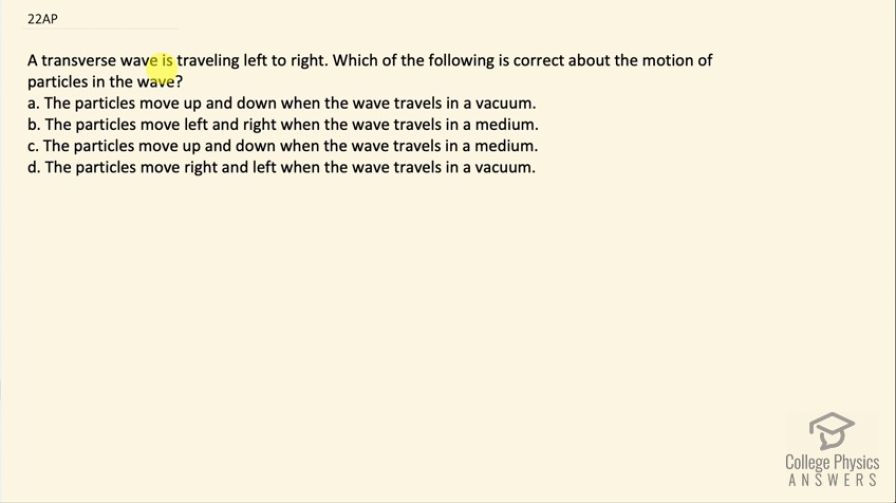Question
A transverse wave is traveling left to right. Which of the following is correct about the motion of particles in the wave?
- The particles move up and down when the wave travels in a vacuum.
- The particles move left and right when the wave travels in a medium.
- The particles move up and down when the wave travels in a medium.
- The particles move right and left when the wave travels in a vacuum.
Final Answer
(c)
Solution video
OpenStax College Physics for AP® Courses, Chapter 16, Problem 22 (Test Prep for AP® Courses)

vote with a rating of
votes with an average rating of
.
Video Transcript
This is College Physics Answers with Shaun Dychko. A transverse wave is traveling from left to right and because it's a transverse wave that means the particles that are moving are moving in a direction perpendicular to the wave propagation so the particles have to be moving up and down in order for this transverse wave to be moving from left to right. So that narrows it down to (a) or (c) because this (a) and (c) both have the particles moving up and down and I guess the difference has to do with this issue of traveling in a vacuum versus traveling in a medium. Now it's a bit confusing because electromagnetic waves can travel in a vacuum and they are transverse waves and one could say that they consist of photon particles in a way. So that suggests maybe answer (a) could work but answer (c) is the one that we're going to accept here... I think... you know... this is not a very good wording to the possible answers here. Another thing is if you had a guitar string in space and you know, it's anchored at both ends— as it would be in a regular guitar— this string would still vibrate and it would be a transverse wave the wave would travel back and forth on this string and the particles of the string would move up and down and so this could occur in a vacuum but I think what they are trying to get at with the vacuum is the fact that well if you have some string particles that means it's not a vacuum anymore because here we have some pieces of string and I think vacuum is to say that there's absolutely nothing physical there... I don't know. Now that's the kind of thing I am thinking about to choose (c) instead of (a).